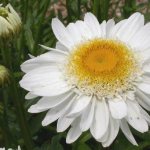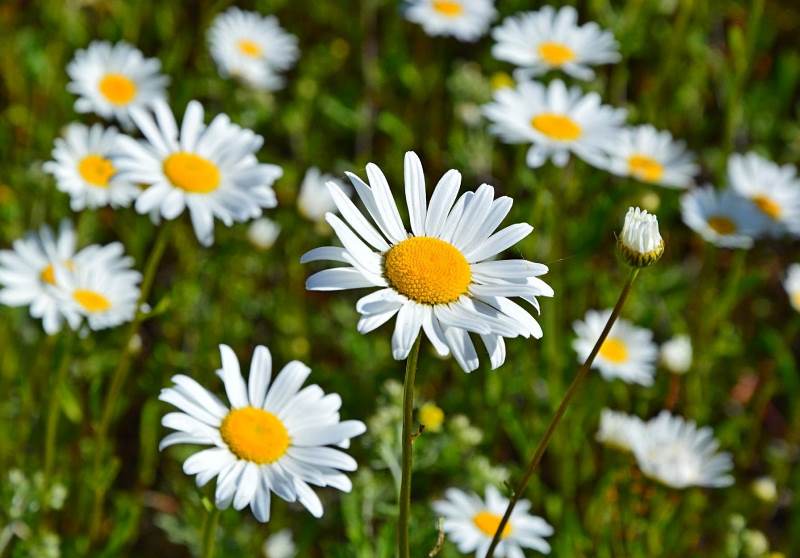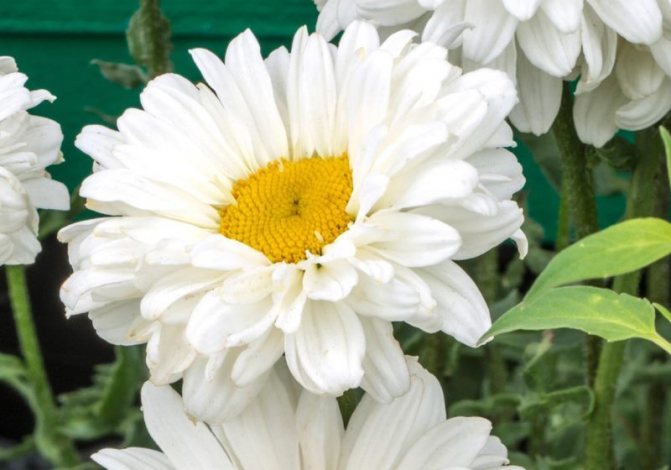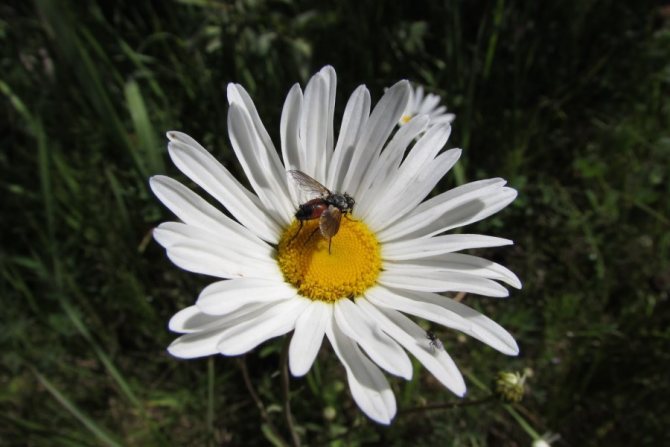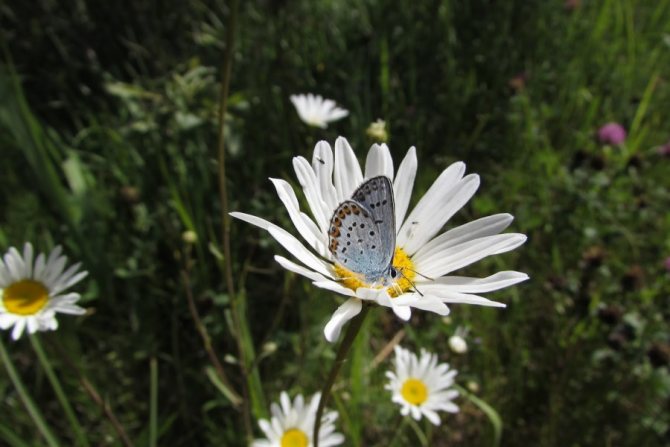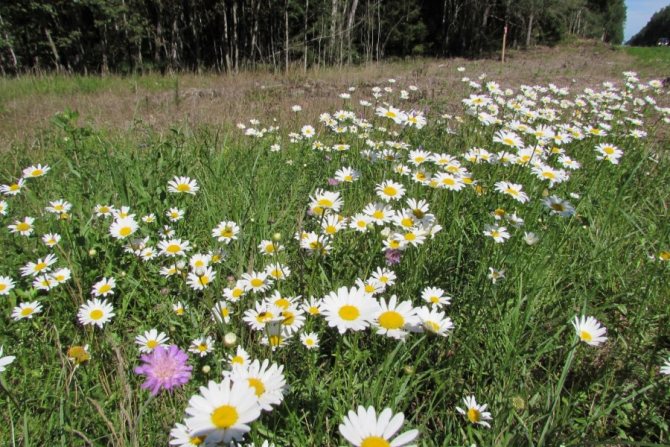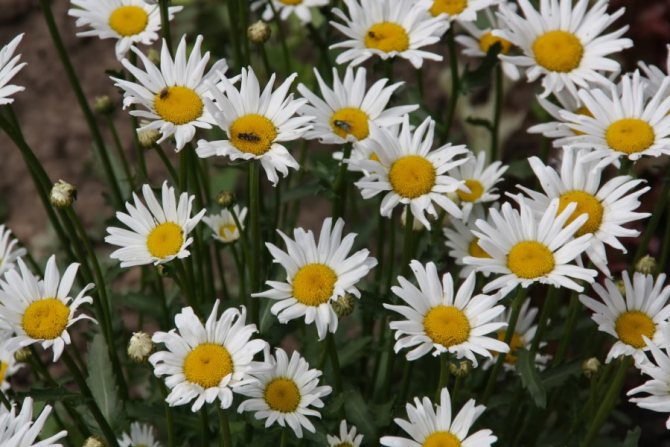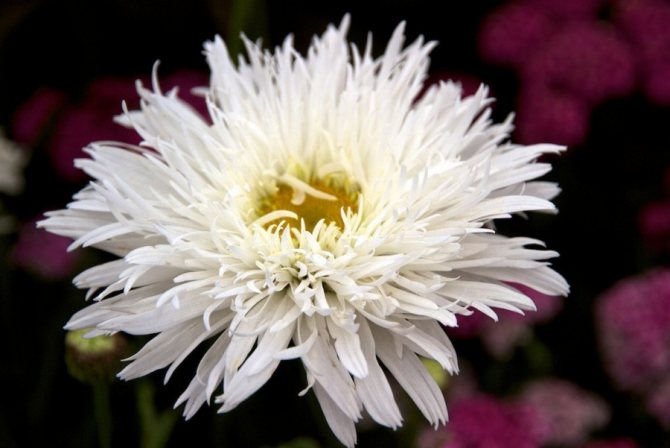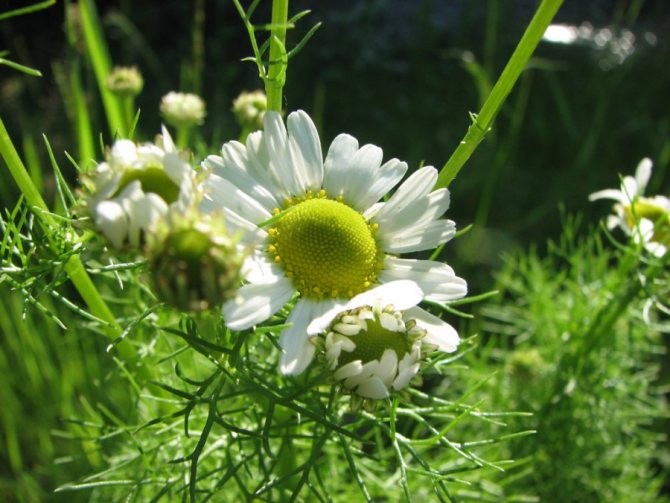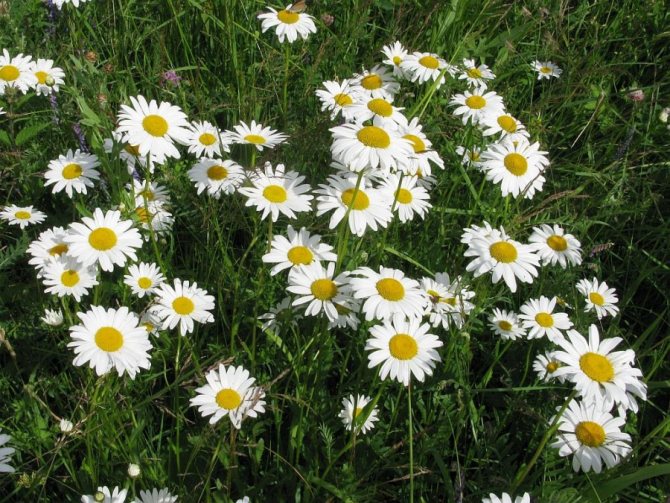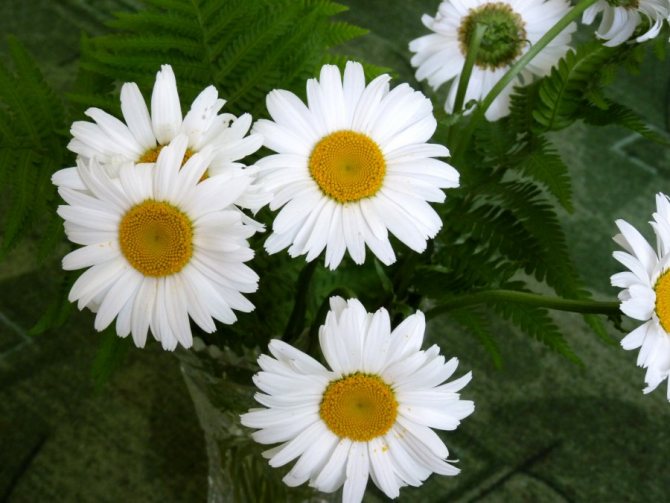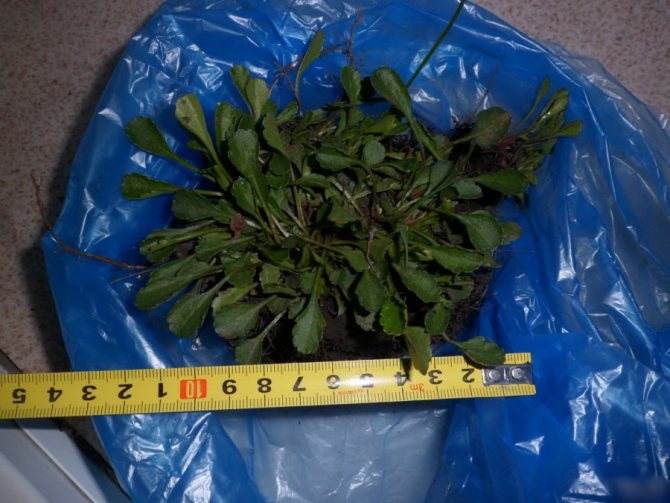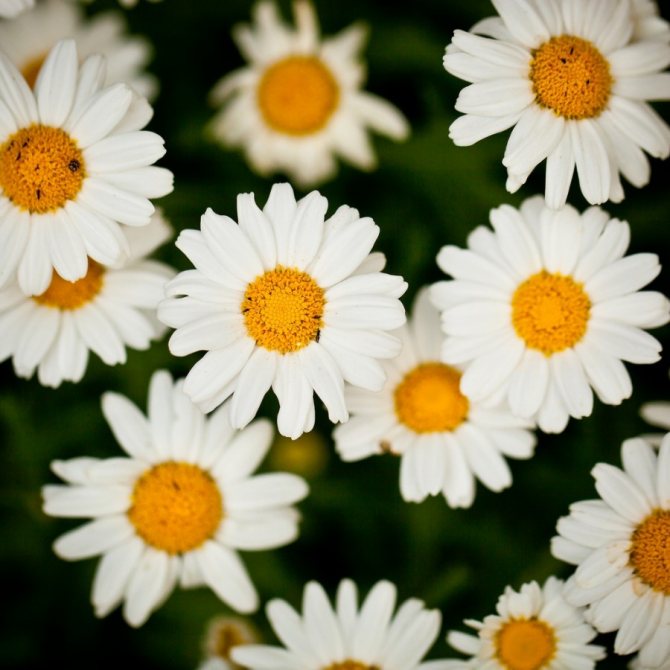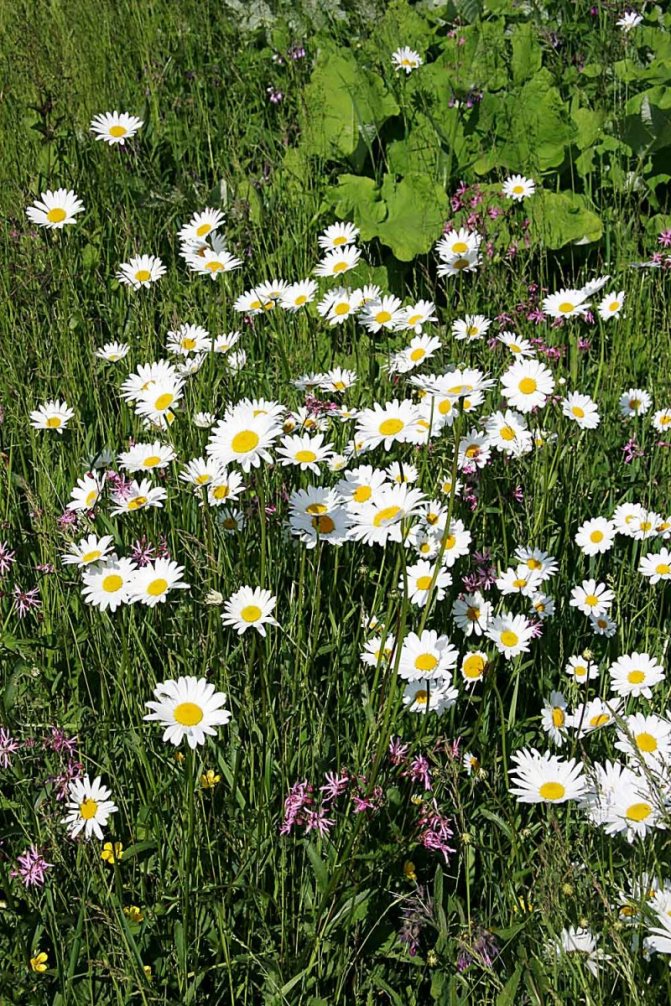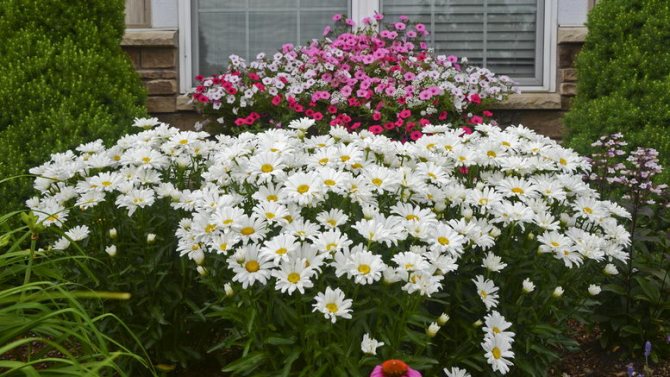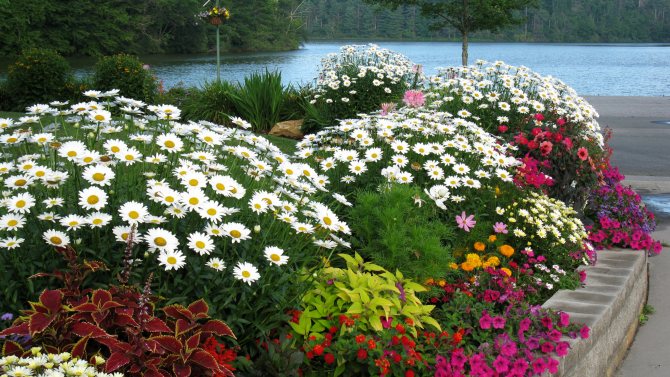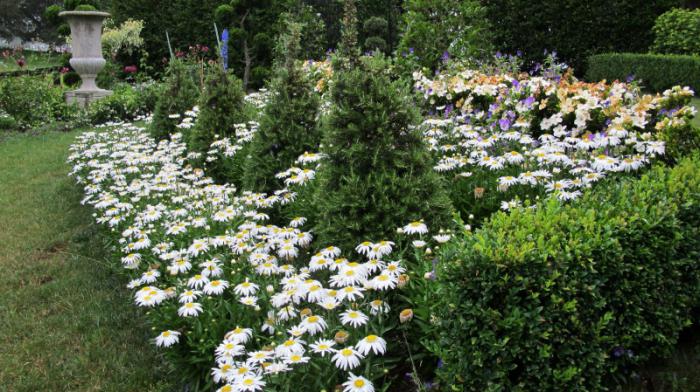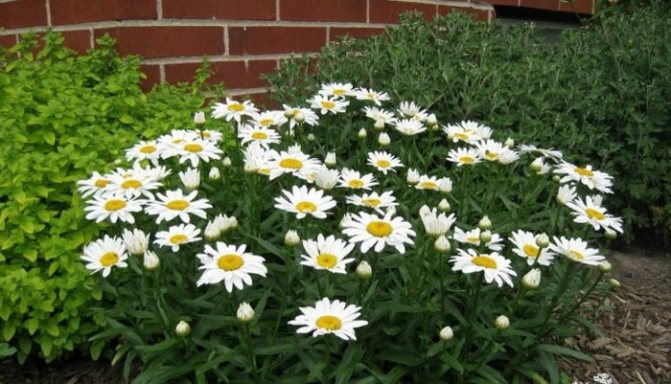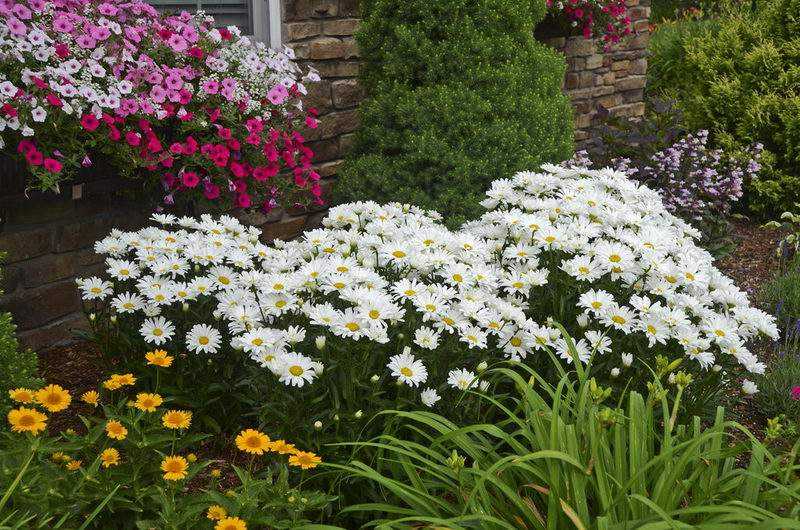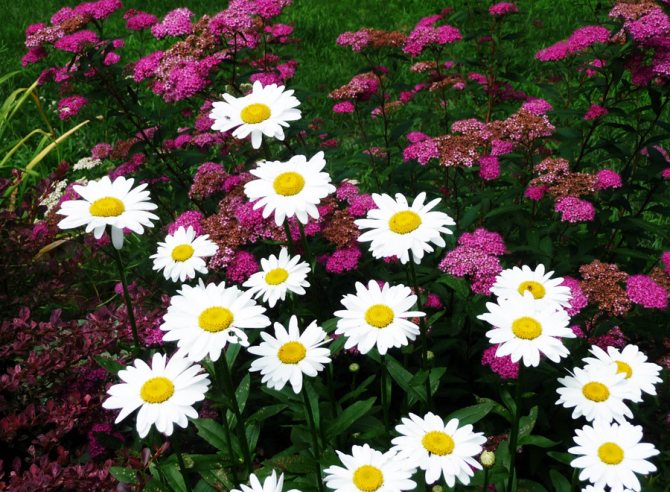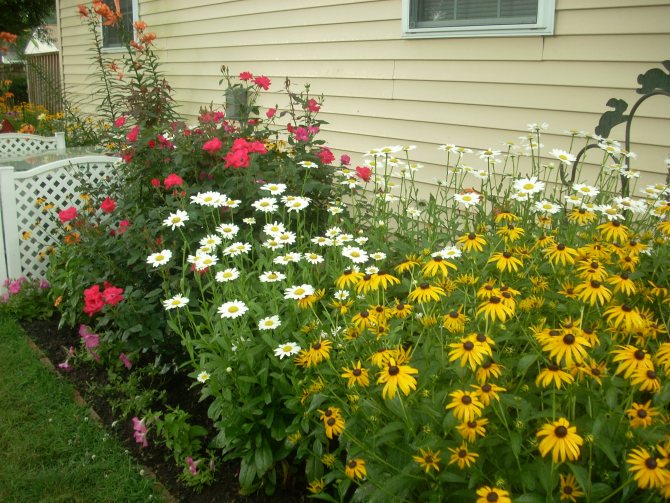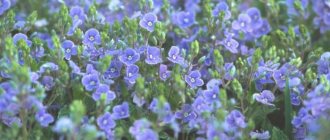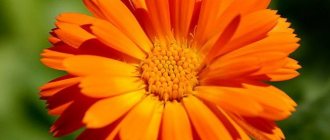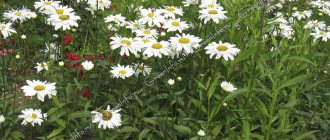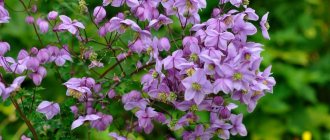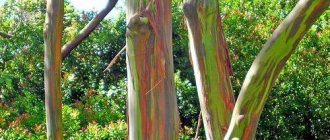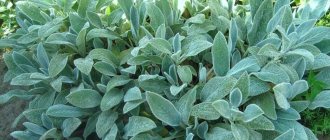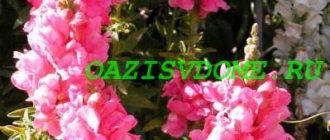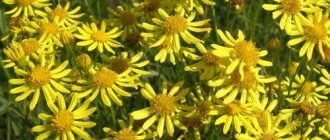The name of the plant comes from the word "cornfield". This refers to a vast, man-made field. These often have white flowers, popularly called daisies. That's what it is nivyanik.
Its Latin name is leukos anthemon. Translation - "white flower". It belongs to the Aster family.
Description of the species
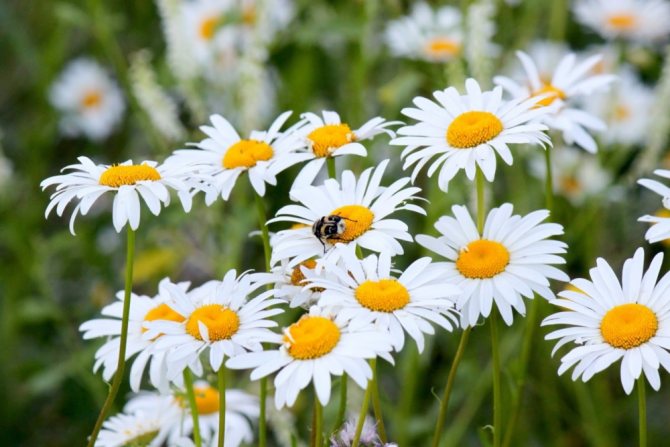
The common popovnik belongs to the numerous Astrov family, the genus Nivyanik. Its name in Latin is Leucanthemum vulgare, which means "white flower". The plant is perennial.
Outwardly, the daisy is familiar to everyone, because it is found everywhere in our country - in meadows, in fields, along roads. The genus of the plant is not too rich, it includes only 20 species, the common daisy is one of them, and we will consider it.
The stem is straight, almost does not branch, it can be of different lengths - from 20 to 130 cm. Inflorescences appear on it in the form of baskets, and bloom with beautiful flowers, their petals are white, and the middle is yellow. At the root, the plant forms a rosette, which is framed by an unsightly-looking foliage - dark green, narrow, oblong, slightly ribbed edges, in some species it is only below, near the ground, in others it is rare, but found throughout the stem. The root of the daisy is fibrous, rather short.
Particular attention should be paid to inflorescences, they reach 3-6 cm in diameter, consist of two types of flowers - in the center are short tubular yellow colors, and at the edges are framed by large reed, pure white (we take them for petals). Flowering is long, begins at the end of May, ends in the last days of July, or even in mid-August. Breeders could not ignore such a beautiful plant, and they bred certain varieties for growing in the garden.
We propose to briefly consider the most interesting specimens:
- Maxima Kenig - differs in large inflorescences, their diameter can be 12 cm. White reeds are located in two rows, and the central tubular ones have a dark yellow color. The stem is up to 1 m high. The plant will delight with flowering for a month and a half starting from mid-June.
- May Queen - the plant is not the tallest of the species, the height of the bush varies between 35-50 cm. The leaves are glossy, shine in the sun, form a dense rosette. Small inflorescence baskets, 5-8 cm each.
- San-Souci - height up to 1 m. The plant is very beautiful, here white reed flowers are arranged in 8 rows, with a fluffy tutu skirt they frame a bright yellow center.
Due to the external similarity, the plant is confused with chamomile, the differences from it are as follows:
- The flowers of the daisy are larger.
- The daisy leaf is whole, dense, while that of chamomile is thin, dissected into many small leaves.
- There is always one inflorescence on the stem of the daisy. In chamomile, the stem branches out, forming many from one, and each has an inflorescence.
- Nivyanik is a perennial and chamomile is an annual plant.
So, just by looking closely, you can easily distinguish these two plants from each other.
Description of perennial flowers nivyanik and their photos
The daisy species are perennials that grow on red rhizomes. One mouth produces erect stems that can range in height from 40 centimeters to 1.3 meters, but in fact are usually almost twice their height.
The following is a description of the flowers of the daisy in all the variety of their forms and varieties.You can also see the flowers nivyanik in the photo, which illustrate the exquisite beauty of flowers during flowering:
Some varieties of daisy have only basal leaves, while others also have leaves along the stem. Some are attached with petioles, while others are attached by the base itself. Foliage is also distinguished in shape: they can be lobed or serrated.
The flower heads are single, paired, or in a group of three on the stem. The base of the head is layered up to 60 centimeters or more rough edges. The head of the daisy has from 13 to 34 rays (petals) of various widths, sometimes more. The radial flowers of the plant are always white, but may turn slightly pink with age.
The fruit is glabrous and ribbed.
In general, outwardly, the nivyanik is an ordinary meadow chamomile, which of course you will not confuse with anything. The following shows a photo of a daisy in various variations of the formation of buds, depending on the type of plant:
Where does the common daisy grow
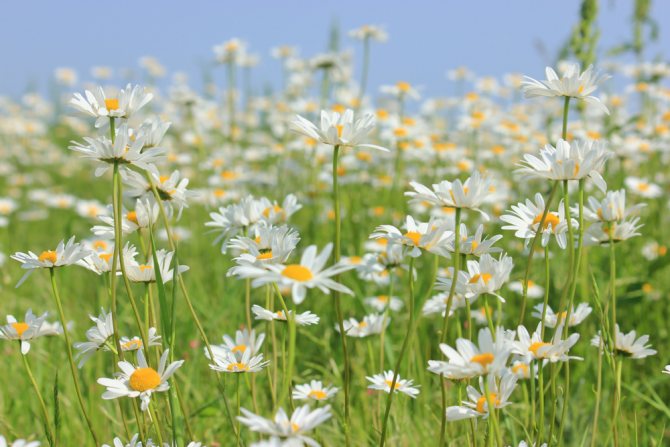

The plant is most widespread in Europe (south and central part). And also the daisy grows in Australia, Asia, New Zealand, North America, Sakhalin and the Kuril Islands.
The flower does not require special conditions for growth, therefore it is widespread. It can be seen on the edges, in the fields, it covers the glades. In the forests, the plant does not feel very comfortable due to the insufficient amount of sun.
Chamomile or not?
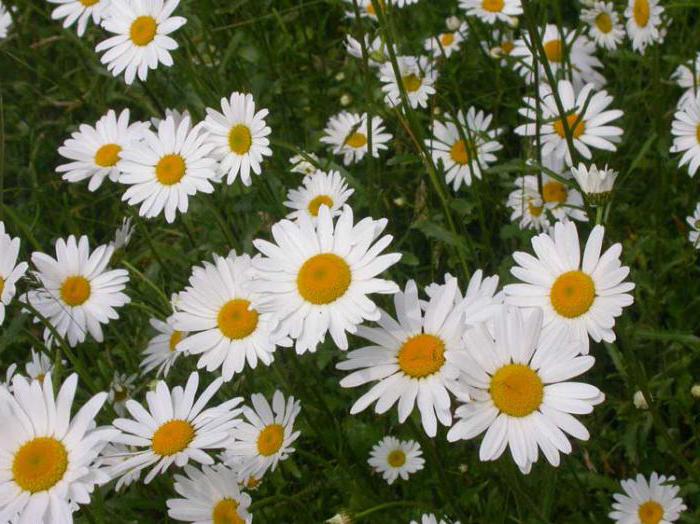

Common daisy is often called chamomile, although from the point of view of botany this is not true. Despite their superficial similarity, they are only distant relatives. You can distinguish them by several signs:
- The white-yellow flower basket of the daisy is larger than that of chamomile.
- The leaves of the daisy are predominantly whole, while those of chamomile are pinnately separate.
- The daisy has one flower basket and only one stem, while chamomile has several inflorescences and a branched stem.
- The meadows are mostly perennials, while chamomile is an annual.
But amateur gardeners still call the flower chamomile-daisy.
Growing features
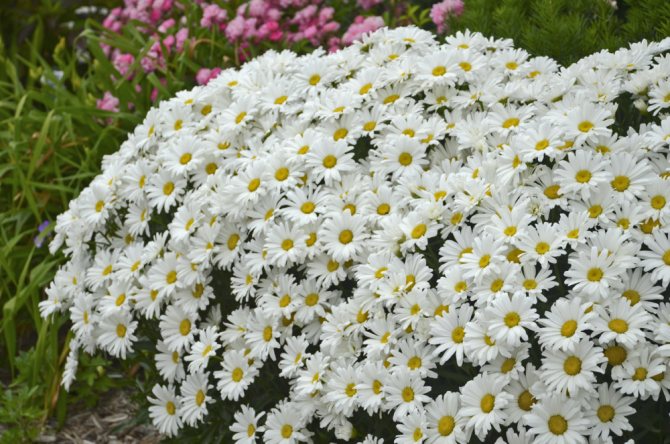

Like any flowering crop, meadow grass is very picky about the composition of the soil. It should be fertile, light, breathable, and drainable.
It is better to grow flowers in an open space, where sunlight will enter in large quantities. In the shaded area, the daisy will also grow, but still the quality of flowering and the size of the bush will undergo changes.
The plant does not tolerate wetlands, damp areas. Therefore, it is recommended to plant the daisy for the first time in open ground in the form of seedlings. In the future, the plant will grow by itself, and next year you will celebrate the replenishment in the flower bed.
If you chose to grow the daisy from seeds right away in the garden, then follow the instructions below:
- Prepare the soil, add humus to it, lime - if the soil is acidic. All these procedures can be done in advance in the fall or early spring, when the ground thaws.
- Sowing is best after the summer season, in September-October, when the soil is warm, but not enough for the seeds to germinate.
- If you chose a spring planting, then wait until the soil warms up and the average daily temperature reaches +10 degrees.
- Make holes or grooves in the garden bed, place the seeds at a distance of 5 cm from each other.
- When the plantings reach a height of 5 cm, you need to thin them out so that there is no thickening.
- Water. In the fall, there will be enough rainwater, and in the spring, water so that the soil is consistently moist, but not swampy.
Seedling method:
- 2 months before the expected planting of the plant in open ground, you need to start growing seedlings.
- Prepare peat pots or jars (boxes) of garden soil. Water.
- Plant the seeds in moist soil, cover with foil, put in a warm, dark place. Maintain moisture, remove the film once a day for 2-3 hours so that the soil does not become moldy.
- After 7-10 days, the first sprouts will hatch.Remove the film, and put the seedlings on the windowsill, where there is more light.
Water and loosen the soil. When the plantings are 6-7 weeks old, they can be transferred to the beds.
As for the rest of the features and rules for growing a daisy in a garden plot, we will take a closer look at this issue further.
Nivyanik application
Like chamomile, daisy has medicinal properties. They are due to the composition of the plant. It contains:
- pain relievers
- inulin useful for the gastrointestinal tract
- fatty oils required for tissue regeneration
- vitamin C normalizing redox reactions
- cancer-preventing carotene
The composition of the daisy is due to its pharmacological properties. In particular:
- The infusion from the plant has a choleretic effect.
- Nivyanik is a diuretic.
- Stirs up the appetite.
- It has anti-inflammatory properties.
- Stimulates the immune system.
- Prevents the development of sclerosis.
- Nivyanik removes toxins and bad cholesterol from the body.
Plus, chamomile tastes good. It is enriched with aromatic herbs. So, the combination is popular meadowsweet nivyanik. Buttercup to the hero of the article is also added. Sometimes tea includes korostavnik. Nivyanik with it it also becomes an expectorant.
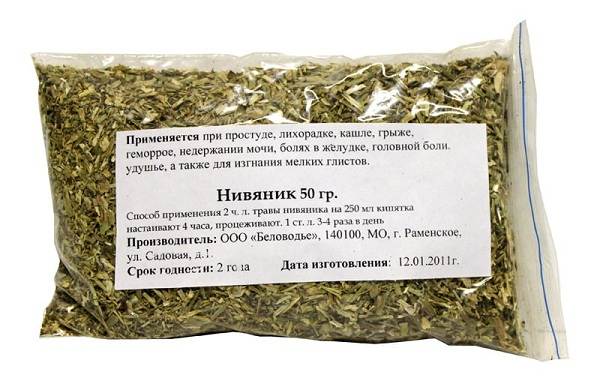

In addition to the benefits for the body, the daisy gives a lot in landscape design. Low-growing varieties are used in alpine slides, making out borders. Tall plants have flower beds in the center. Nivyanik looks like one bush or thickets.
Preparing for landing
No special preparation is required. It is enough to harden the plants, so they are less likely to get sick in a new place.
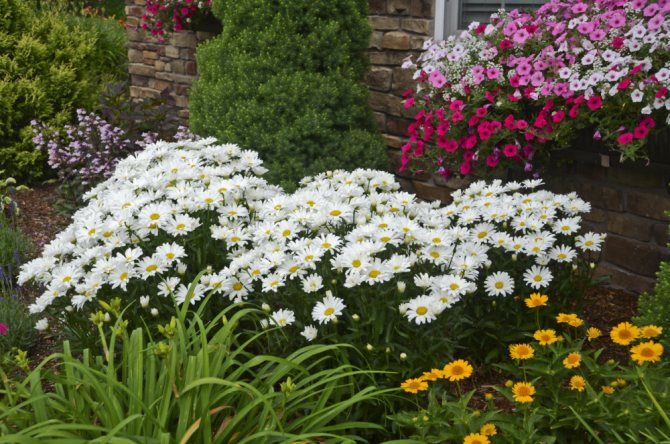

You need to harden a week before disembarkation, this is done as follows:
- Choose a warm day, take the seedlings out to the balcony or outside. If there is no way to transfer, then leave the window open. Plants need to "walk" for 2 hours, then bring them into heat.
- On the second day, leave the bushes to cool for 3-4 hours.
- From the third day, you can take seedlings outside for the whole day. Be sure to bring it in at night.
The last 2 days, it is necessary for the plantings to be constantly on the street, because then the plant will have to live outside the walls of the house. It doesn't matter if it's raining outside (put it under the roof so that the pots don't flood), it's cool (at least +7 degrees), the daisy adapts to weather conditions faster.
Varieties
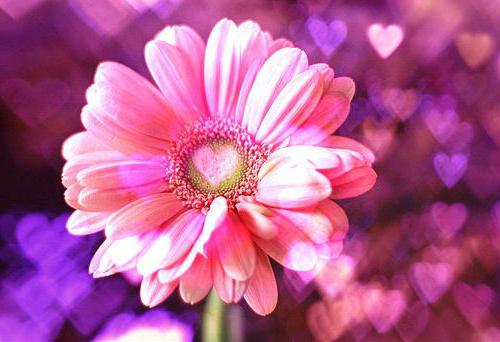

The genus Nivyanik includes about 20 species. The most famous of them are:
- Common lemongrass, or meadow chamomile (L. vulgare Lam).
- Nivyanik the greatest (L. Maximum).
- Marsh daisy (Leucanthemum paludosum).
- Nivyanik Kurilskiy (Leucanthemum kurilense).
Common cornflower, or popovnik, blooms from late spring to early autumn. Varietal daisies are distinguished by larger flowers, and they do not grow much. There is no particular variety in the common daisy varieties. As a rule, they differ only in height. The most widespread variety is Mei Queen, its height is about 50 cm. Many varieties were obtained from the largest daisy. The main difference between this species and its hybrids is the later flowering compared to the common cornflower. When choosing varieties or hybrid forms of the daisy, be sure to take into account not only the attractive appearance, but also the botanical features of the plant, care requirements, as well as frost resistance. The choice of varieties and hybrids is unusually diverse: high and low, double and semi-double, with rounded and ragged edges, all kinds of colors, etc. One of the most unusual varieties is Lacrosse. The plant is about 40 cm tall with white petals slightly curled into a tube with cut tips. Terry varieties - Snow Maidens, Aglaya and others - have original flowers resembling buttons, with very short petals. The original Old Court variety features flowers with many narrow, curly petals surrounding a yellow center. Nivanny varieties with the usual petal shape are also very diverse.For example, the low grade Snow Kep is perfect for curbs. Not so long ago, the Banana Cream variety appeared - with yellow reed flowers. They are distinguished not only by their spectacular appearance, but also by the compactness of the bushes and abundant flowering. The terry variety Crazy Daisy is very popular. Its height can reach 90 cm. In the garden, it sets off well ornamental shrubs and looks great in flower arrangements. Nivyaniki are not only a decoration of the garden, they also provide an excellent cut. Plants can stand in water for a long time, especially terry varieties. And most importantly, they look great in any bouquets and flower arrangements.
Planting in open ground
Planting of a squirrel in the beds is carried out only in warm weather, when the plant will not be threatened by frost. Choose a warm, but not hot day, better in the evening. So, nothing will hurt the fragile leaves, during the night the plant will rise, and the next day it will be fun to stick out of the flower bed.
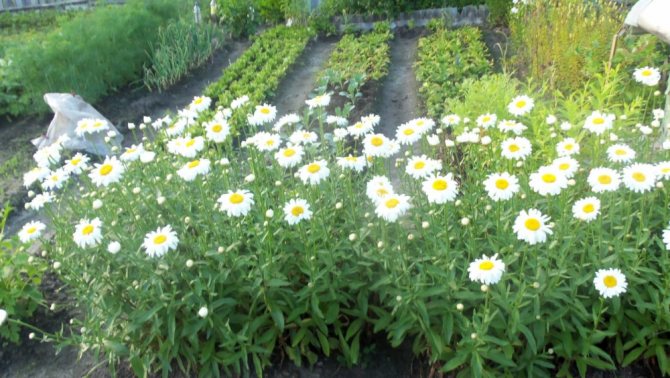

Transplanting from pots is carried out according to the following scheme:
- Carefully remove the plants from the boxes along with a clod of earth, so the roots will suffer less.
- Make depressions in the soil according to the size of the volume of the roots + another 5 cm deep.
- Put fertilizers on the bottom, it can be a mixture of peat with rotted compost. Layer thickness 5-7 cm.
- Place each plant in a separate hole, sprinkle with fertile soil.
- Tamp the soil with your palms, water.
- You can mulch the ground with dry foliage, sawdust or rubble.
If there is water in the planting zone after the rains, make a ditch around each plant at a distance of 20 cm, excess moisture will drain into it.
The choice of soil and place for planting seedlings
The cornflower, planting and caring for which are described in the article, loves fertile soils, well-drained, sufficiently moist and non-acidic. On insufficiently moistened and poor soils, the flowers become small, therefore mulching is often used to retain moisture in the soil (this can be cut grass, shavings or chips). Well-rotted organic fertilizers are added to poor soils: for heavy soils - 20 kg per 1 square meter, and for light soils - 15 kg per 1 square meter. It is important to know that the common daisy, the description of which is given above, does not tolerate heavy clay and light sandy soils, and in too damp areas these plants are susceptible to fungal diseases. Well-lit, sunny areas are a good place to plant. Lack of light negatively affects plant development and flowering.
How to care for a nivyanik
Despite the fact that the plant is also found in the wild, the daisy is very demanding to care for. If you do not follow simple rules, then the inflorescences will become small and faded, and the foliage will look rough.
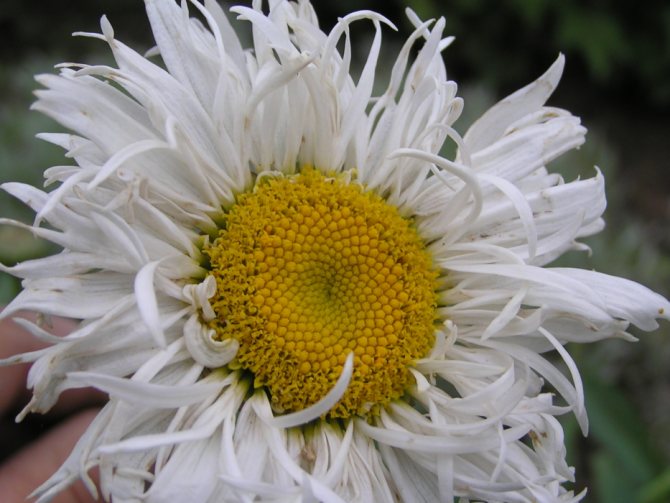

If you want the beautiful "chamomile" to become a decoration of the garden, follow the instructions below:
- Watering. The sycamore grows well on moderately moist soil. The soil should not dry out, but it is also impossible to flood it, creating a swamp. In a dry summer, watering from a watering can is done daily, in the evening, when the sun goes down the horizon. The plant loves to swim, and will gladly substitute its petals under the drops of water. If the summer is rainy, then do not water. On moderately hot days, watering is worth every 2-3 days.
- Loosening. Take this procedure one day a week after watering. Loose soil provides better air and water supply.
- Weed. In the vicinity of the weed grass, the daisy crushes, since it will not have enough nutrients.
The plant reacts very well to feeding. You can fertilize with mullein, manure, and use universal fertilizers for garden flowering crops. It is enough to feed the daisy once a week.
After flowering, prune with a sharp, alcohol-treated or fire-treated pruner. Remove dried stems, foliage, flowers.
For the winter, the plant in regions with a harsh climate and little snow cover should be covered. The root passes almost at the surface of the soil, and it can freeze and die. In warm regions and in areas with a temperate climate, shelter is not made.Hay, spruce branches, peat are used as a "blanket". When the snow melts, the insulation is removed.
Reproduction methods
There are simple ways to propagate a plant on your site - by cuttings and root division. Let's describe both options.
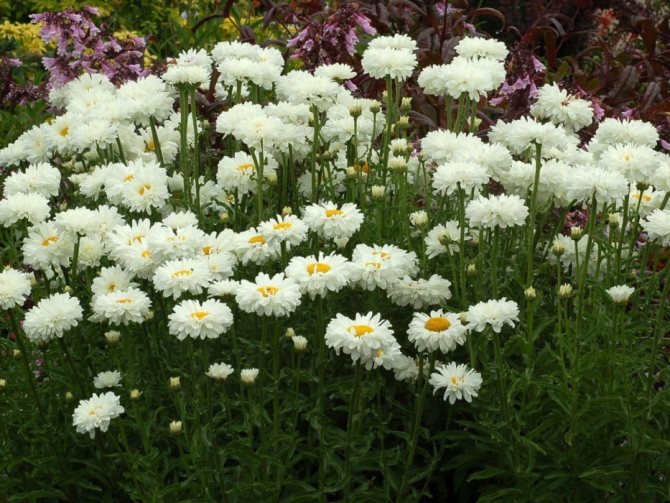

Cuttings:
- The method can be applied in August and September, when the plant has faded. For this, strong root rosettes are used.
- Cut the rosette from the root with a sharp knife so that the leaves do not fall apart.
- Dig in the stalk where it will grow continuously. Water well.
- Rooting occurred if new leaves appeared.
- While the flower is getting used to the new bed, you need to keep the soil moist, otherwise the plant will die.
Dividing the root is an even easier way.
The rules are as follows:
- You need to divide the bush when it reaches the age of three. This is a mandatory procedure that must be performed, even when there is no desire to propagate the daisy. If you do not make a division, then by 4 years the inflorescences will become small, and the bush itself will lose its decorative effect, becoming woody and coarse.
- The procedure is performed in the spring, when the green mass is just beginning to grow, or in the fall, after flowering.
- Cut the roots with a sharp knife, each shoot should have a strong rhizome.
- Plant the squirrel at a distance of 30 cm from each other, water and mulch the soil around.
The second method of reproduction is more preferable, because in this case the plant retains all the parental varietal qualities.
Agrotechnics
Nivyanik is a wonderful decoration of the garden, and after cutting, its flowers can stand for more than a week. Nivyanik begins to bloom at the end of May, flowering continues until mid-July. To extend the flowering time, wilted peduncles must be removed so that the flower does not expend energy on the formation of seeds. After the first flowering, the plant does not rest for long and blooms again - in late summer, early autumn.
Nivyanik is a perennial plant that grows in one place for 4-5 years, forming strong bushes with large flowers. With age, the bush becomes bare, so the roots of the plant must be separated and transplanted.
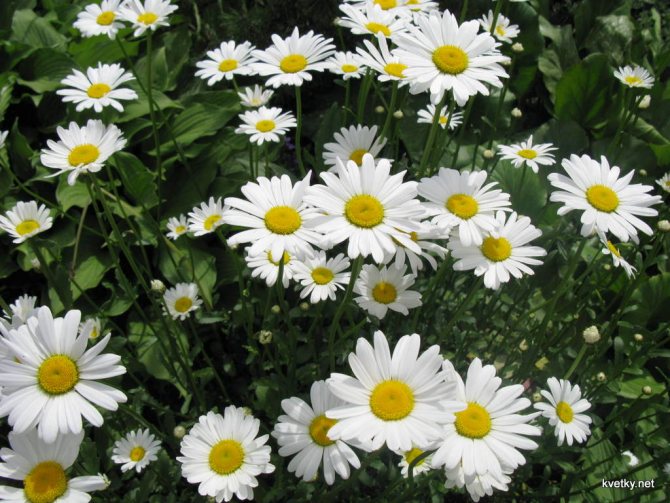

It is not difficult to grow a daisy, caring for it does not take much time. The place for planting a flower should be light, and the soil should be light, moisture and air permeable, fertile and not acidic. The grassland will grow poorly on light sandy or heavy clay soil.
A flower bed or a flower garden for planting a cornflower is prepared in advance, for this, when digging, compost or humus is introduced into the soil.
Caring for a cornflower in the garden consists of planting, watering, weeding, hilling, loosening the soil and dressing. Plants are planted at a distance of 30-50 cm from each other, because the planting is carried out for several years, during which the bush grows.
When planting, the seedlings are removed from the container along with the soil, and transplanted into a prepared hole. After planting, the soil is compacted and watered again. The soil under the flowers is mulched with any material suitable for this.
For high-quality care, you need to water the flower sparingly - you should not overmoisten the soil, from this the roots of the plant will deteriorate. At the same time, it should not be allowed to dry out, so that the plant does not wither.
Caring for the plant also consists in tying a peduncle with a heavy flower, although in adult plants the peduncle is strong enough and is able to hold the flower on its own.
To strengthen the flower and prevent deformation of the stem, it is slightly spud with earth, in addition to support, this procedure gives the plant additional nutrition. Semi-double and double varieties with heavy large flowers are especially in need of hilling.
Caring for the daisy implies timely feeding with mineral and organic fertilizers. During the growing season, the plant is fed with nitrogenous fertilizers, and during flowering - with potassium-phosphorus fertilizers. In addition, on the eve of flowering, bone meal can be added to the soil.
The flowers of the daisy are cut at the beginning of the wilting process, and the leaves and remnants of the stems - in the fall. Thus, only the roots of the plant overwinter in the soil.
The daisy is considered a frost-resistant plant; in the wild, it grows without human care. It is not necessary to insulate the common cornflower for the winter, however, hybrid terry varieties can die from severe frosts, therefore they are covered with dry grass, leaves, spruce branches or other materials. In the spring, the cover is removed and burned so that with the onset of heat, the flower begins to develop without hindrance.
Pest and disease control
Nivyanik is very rarely exposed to diseases, but still there is a risk in rainy and cold summers.
The following diseases can harm the plant:
- rot at the roots and along the stem;
- powdery mildew;
- rust;
- fusarium.
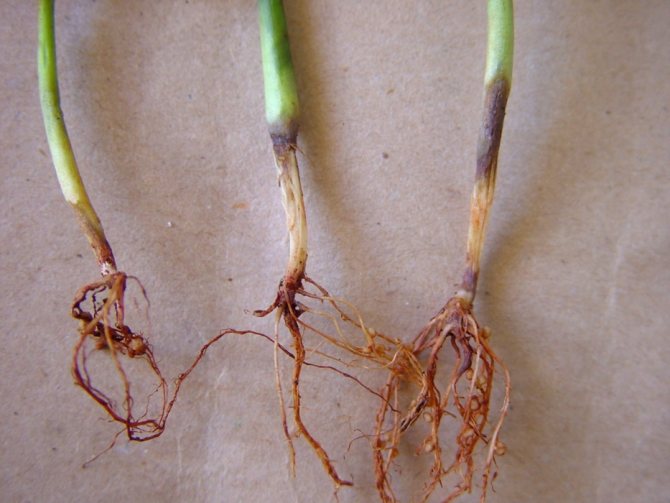

Bordeaux liquid will help with all these misfortunes. Processing must be done for all plants, when signs of ailment are seen on at least one:
- Remove the damaged areas, if the daisy is badly damaged, then it must be dug out, removed from other flowers.
- Treat with 1% Bordeaux liquid solution.
- Repeat the procedure 3 more times - with an interval of 3 days.
Of the pests, aphids are threatened. A water solution with ash and laundry soap will help get rid of the parasite:
- Dissolve 2 tbsp for 10 liters of water. l. laundry soap and 300 g of wood ash.
- Process the bushes, pour the rest under the roots.
Powder the greens, still wet after watering, with tobacco ash (once a week), it will protect the plant from any pests.
Literature
Wikisource has texts on the topic Chrysanthemum Leucanthemum
- Ch. ed .: Gilyarov M.S .; Editorial board .: Baev A.A., Vinberg G.G., Zavarzin G.A. and etc.
Biological encyclopedic dictionary. 2nd ed., Revised .. - M .: Sov. encyclopedia, 1989. - Plant life. In 6 volumes. Vol. 5. Part 2. Flowering plants / Ed. A. L. Takhtadzhyan. - M .: Education, 1981 .-- P. 472.
- Gubanov I.A., Kiseleva K.V., Novikov V.S., Tikhomirov V.N.
Illustrated guide to plants of Central Russia. - M .: T-in scientific publications KMK, Institute of technological research, 2004. - T. 3. - P. 457. - ISBN 5-87317-163-7. - Botany. Encyclopedia "All Plants of the World": Per. from English (ed. Grigoriev D. et al.) - Könemann, 2006 (Russian edition). - S. 519-520. - ISBN 3-8331-1621-8.
- Felicity Barringer
... Wildflowers Find Favor With Highway Gardeners. Article in the New York Times. August 29, 2007.
Interesting facts about the plant
Nivyanik has long been known in our area, and earlier it had many names.
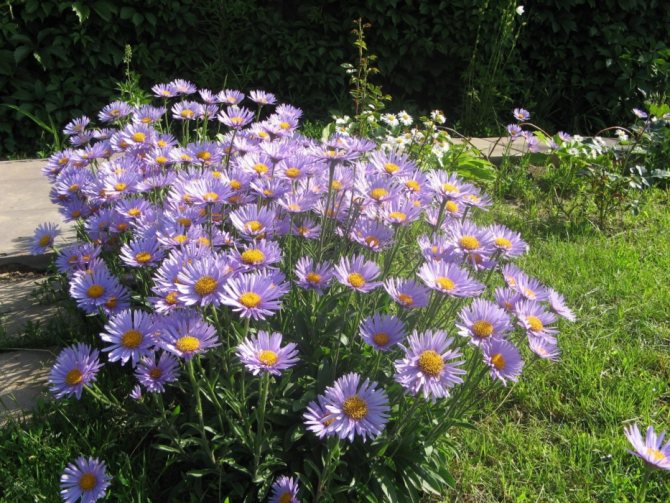

Some of the names of the plant can still be heard today:
- ivan's color;
- daughter-in-law;
- forest Maryasha;
- whitewash grass;
- tyagun;
- hen-party;
- sunflower;
- beliushka;
- whitehead;
- winglet;
- path.
The last name is quite justified, because it was on the nivyanik that the girls were guessing about the groom “love or not love”.
Another interesting thing is that it seems to us that we see one flower - white petals and a yellow anther. This is not at all the case. We look at the whole inflorescence, so the yellow flowers have a tubular shape, and the white ones, which we take for petals, are also flowers, only reed-shaped.
Nivyanik pests
The hero of the article is resistant to pests. They usually "conquer" weakened plants. Excessive or insufficient watering, unsuccessful shady location can "mow down" them. Then the flowers are settled:
- Thrips. These are small insects with an elongated body and the same narrow wings. On chamomile petals, thrips look like black dots, darkening the snow-white buds.
- Miners. This is the name of the larvae of flies or moths. They settle in the leaves, making moves in them.
- Pennits. These are homoptera insects from the cicada family. Pennies have bubble-filled saliva. Insects envelop her leaf stalks and stems.
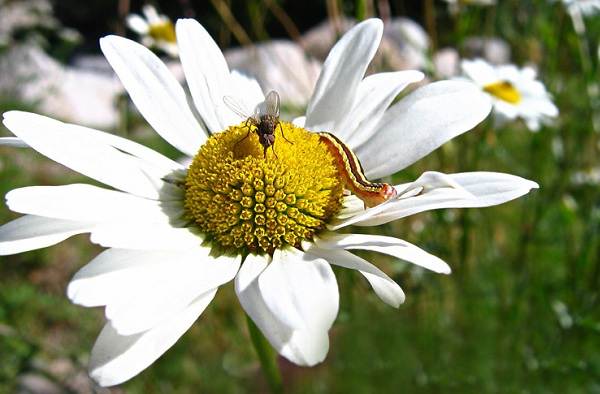

After prolonged downpours, white spots with the same bloom and a brown border may appear on the leaves of the daisy. This is giardiasis. White rot is also likely. With her, the bases of the stems are destroyed, covered with a milky bloom.
What is terry
Flowering terry is an abnormality associated with an increase in the number of petals during the transformation of other parts of the plant caused by external factors.Terry daisy is achieved by selecting different varieties, adding or depriving certain nutrients, infection with a bacteriological or viral disease that does not affect the viability of the plant.
Sometimes terry varieties are sterile, like other hybrids, or, more often, are deprived of the ability to transfer modified genetic material through growing from seed to the next generation. If, for some reason, mutations are persistent, transmitted to new plants through seed, then such a hybrid becomes a variety.
Nivyanik in landscape design
This culture is often used for single and group plantings. Nivyanik are suitable for decorating a country-style plot. Low-growing varieties are often used to decorate alpine slides or borders.
Large shrubs of leucanthemum go well with calendula, poppies and bells. Daisies and marigolds often become neighbors for low varieties. Also, flower beds with garden chamomile are often complemented by cereal plants.
Photo:
How to make a cure medicine
Preparing a potion is simple:
- Drinking infusion - pour 2 large tablespoons of dried herbs with flowers with a liter of boiling water, boil for 3-5 minutes over low heat, cool. Then strain through a double layer of cheesecloth. Drink 20 g 3 times a day.
- For douching - 2.5 tablespoons pour two glasses of boiling water, boil for no more than 5 minutes, cool. Strain very thoroughly. Use warm overnight.
- For lotions - a strong decoction is prepared at the rate of 1 tablespoon (no top) of dry raw materials for half a glass of boiling water.
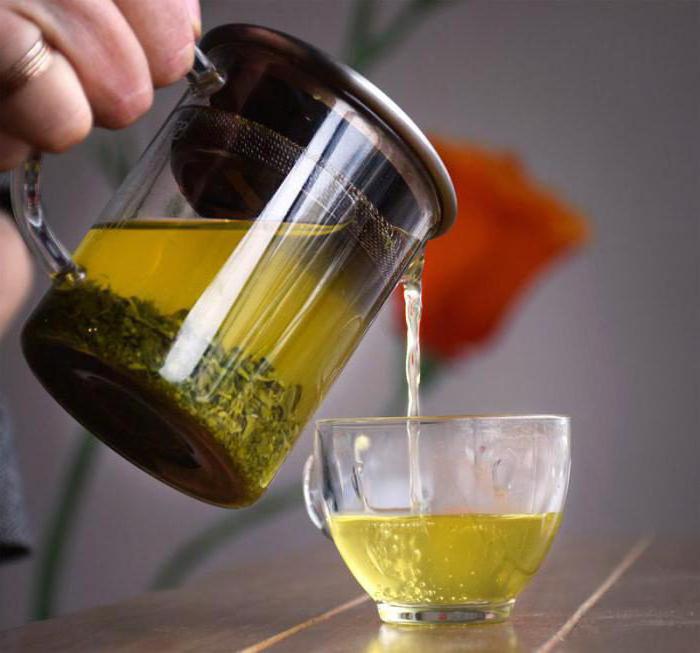

- Alcoholic medicinal tincture - take fresh leaves of cornflower and nettle in equal parts, wash, dry. Grind in a blender or through a meat grinder. Pour the green mass with an equal volume of medical alcohol. Insist 15 days in a dark place. Strain the finished tincture. Take 20 drops twice a day.
- Ointment - 2-2.5 tablespoons of dry grass and meadow chamomile flowers pour into a saucepan, squeeze out a small tube (50 ml) of baby cream there. Put in a water bath for 30-40 minutes, while the drug must be constantly stirred with a wooden spatula. After cooling, apply a thin layer to the affected area three times a day. Store the ointment in the refrigerator.
The best varieties of nivyanik with photos and names
Leucanthemum crazy daisy
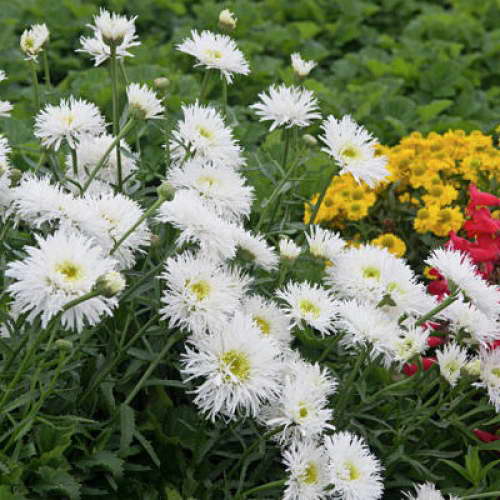

Leucanthemum Crazy Daisy Leucanthemum Crazy Daisy Photo
The amazing beauty of terry chamomile of the Crazy Daisy variety with thin petals is comparable only to the beauty of a white chrysanthemum. Spectacular snow-white flowers will become a bright backdrop for colorful neighbors.
Leucanthemum giant
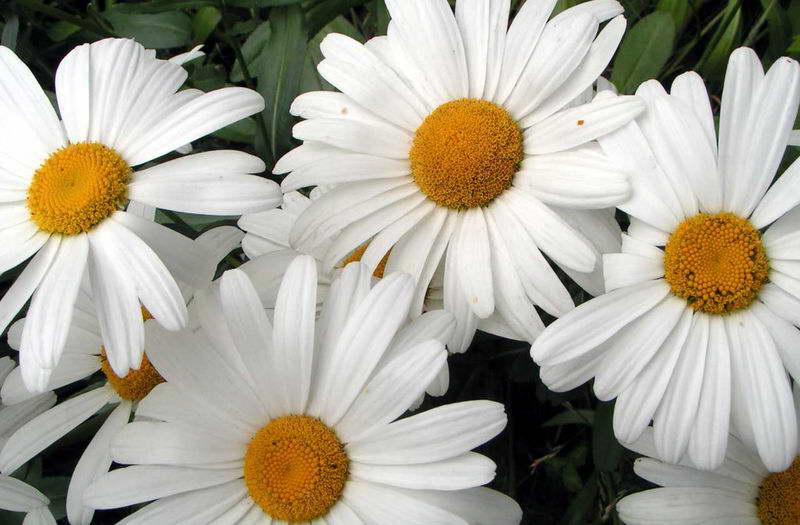

Nivyanik giant giant photo
Have you ever seen a chamomile with a flower diameter of 12 cm? This splendor is given by the Giant variety, which is as easy to care for as an ordinary field chamomile: planted and forgotten. Unless in a severe drought, it is worth taking care of the beauty so that she will endow with a lush color.
Nivyanik the largest Silver Princess Leucanthemum x superbum ‘Silver Princess’
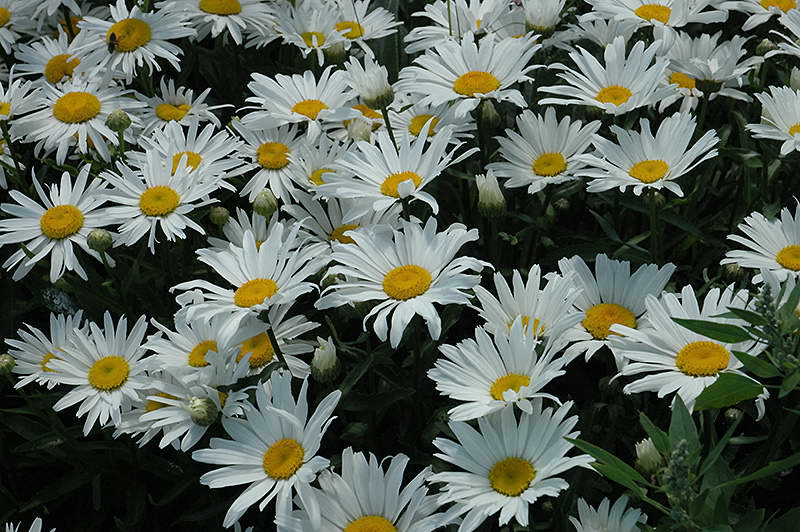

Nivyanik Silver Princess Leucanthemum x superbum ‘Silver Princess’ photo
Chamomile variety Silver Princess stands out for the depth of color of dark green leaves with a blue tint, which is why the plant has a special nobility. Numerous snow-white flowers with delicate thin petals are a fantastic sight.
Leucanthemum Fiona Goghill Leucanthemum Fiona Goghill
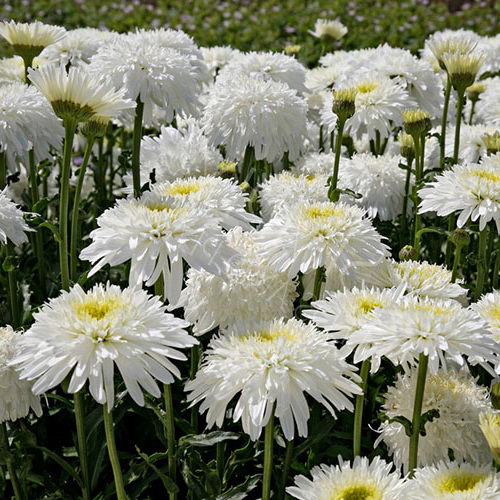

Nivyanik fiona goghill Leucanthemum Fiona Goghill photo
A sight for sore eyes: dense double flowers of the Fiona Goghill variety with lengthening petals on the outer layers of the corolla. The yellow centers are also densely filled. You won't even guess that this is a nivyanik. It looks like either a terry aster, or a chrysanthemum.
Leucanthemum x superbum ‘Snow Lady’
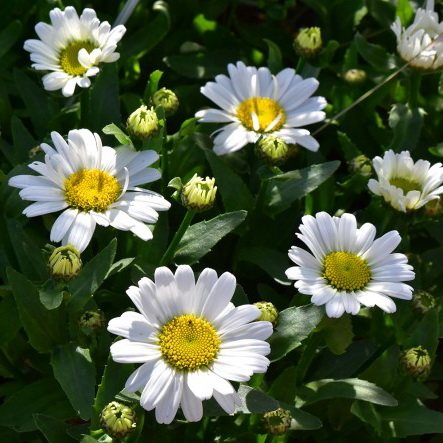

Leucanthemum x superbum ‘Snow Lady’ photo
Stocky, powerful compact bushes with dense dark green leaves are crowned with large flowers with wide petals.Low growth, special splendor of this chamomile breathes romance and lightness.
Nivyanik Wirral Supreme Leucanthemum superbum ‘Wirral Supreme’
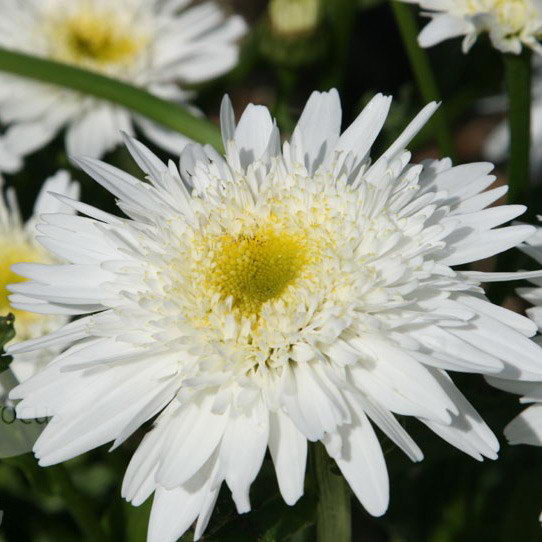

Nivyanik Virral Supreme Leucanthemum × superbum ‘Wirral Supreme’ photo
Another stunning terry variety is Wirral Supreme with large flowers that give the impression of scattered pointed stars on the compact, low shoots of the plant.
Leucanthemum superbum ‘Alaska’ cultivation of leucanthemum alaska
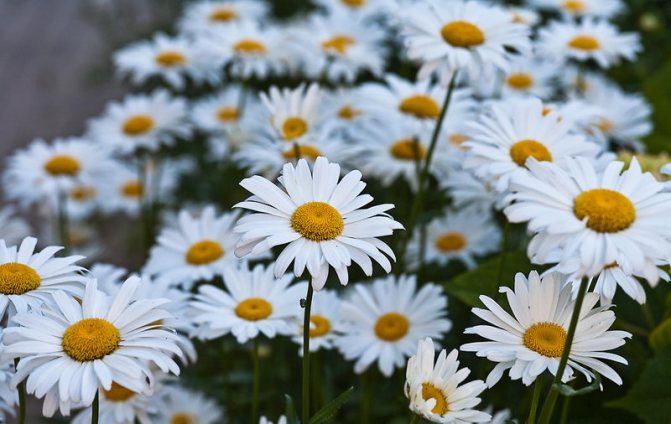

Leucanthemum × superbum ‘Alaska’ photo
The Alaska variety is interesting for its delicate flowers on thin stems, densely filling powerful bushes. Looks great as a curb plant planted in parks.
Myths and legends
Nivyanik ordinary personifies innocence, is considered a symbol of unrequited love. In nature, it grows in most of the territory of Russia and, thanks to its snow-white petals, is a favorite flower for the simplest fortune-telling - it does not like it. There are many myths and legends about this flower. They all tend to talk about love, anticipation and loneliness.
One of the legends tells of a field fairy who fell in love with a young shepherd. The fairy taught him the secrets of healing with herbs and endowed him with the strength of a healer, in the quiet hope of tying the young man to herself. But the shepherd boy, having received secret knowledge and power, began to use them for his enrichment and gradually forgot about the one that endowed him with these gifts. The fairy was waiting for him, suffered, cried, and every tear that flowed from her eyes turned into a chamomile. And the fairy herself was thinning and melting. The strength of the former shepherd also melted. He remembered about the fairy only when she died, and the magical powers left him forever. The young man came to that meadow, but instead of a fairy he saw a huge field of daisies ...
Botanical description of the herbaceous perennial nivyanik
According to the botanical description, leucanthemum is a perennial herbaceous rhizome plant with abundant and long flowering. Blooms from late June to late August, there are varieties that bloom in late May.
Differs in strong tall stems 60-100 cm high. Stems are flower stalks ending in inflorescences up to 15 cm. Consist of a yellow center and snow-white petals around it, large petals, arranged in 1-2 rows. In double forms - in several rows from the yellow center and white petals around it.
When describing the daisy, it is also worth noting that, growing, it forms thickets and, in full bloom of its beauty, pleases the eye with white-yellow caps of flowers, but each inflorescence does not bloom for long - only twelve days. A lot of seedlings are formed: one plant can produce up to 25,000 of them.
During the cultivation of this flower, many varieties with large baskets were bred, terry forms were obtained. Currently, several main types of daisy are used in ornamental gardening. The cultivars are united under the name "garden chamomile".
Contraindications
There are few contraindications to use in the treatment of this plant, but a doctor's consultation is required. Forbidden for pregnant and lactating women, as well as people with severe hypotension. It is also worth refraining from treating this flower for people with an individual intolerance to the daisy. If you do not observe any signs of the above diseases, consult your doctor before use.
There are cases when the disease has not yet made itself felt, and the use of a medicinal plant will aggravate the onset of the course of the disease.
Etymology of the name. Synonyms
The Latin name for the flower is Leucanthemum vulgare. Comes from two Greek words:
- leukos - translated into Russian as "white";
- anthemon means flower.
Thus, the scientific name is closely related to the appearance of the flower, which looks like a white daisy.
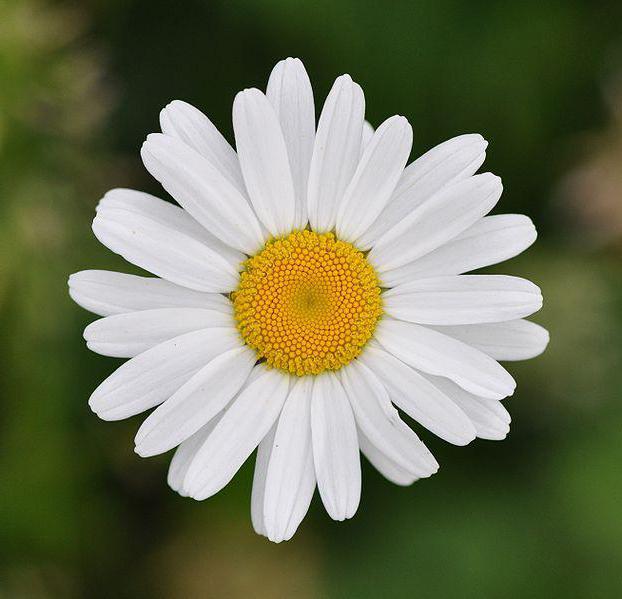

Nivyanik is the Russian name for the plant. It comes from the word "cornfield", which means a wide treeless space. Considering that the daisy grows on open plots of land, it can be assumed that the Russian name of the flower characterizes its distribution.
The people call this chamomile (nivyanik) differently: white-headed, navel, popovnik, belyushka, meadow nivyanka, roman-grass, white flowers.
Reproduction by division and cuttings
Cuttings are made in July-August. It is necessary to take the basal processes, which have formed a rosette, with a rhizome. Cuttings are planted in the wells in the same way as seedlings. Then watering is done.
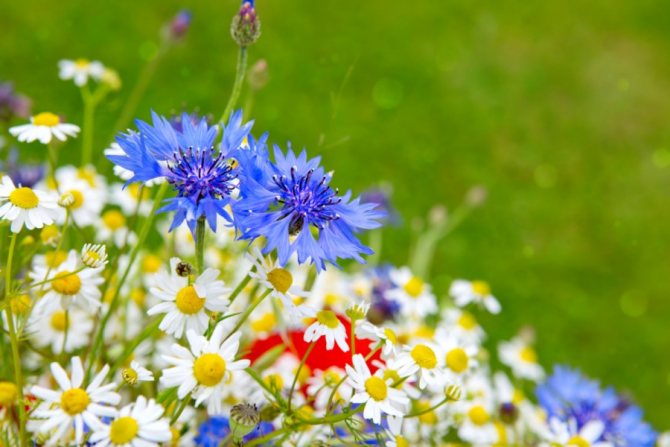

During a 4-5 year period, the daisy grows. The flowerbed becomes excessively thick. Therefore, it is necessary to divide the bushes in the spring or at the end of September after flowering is complete.
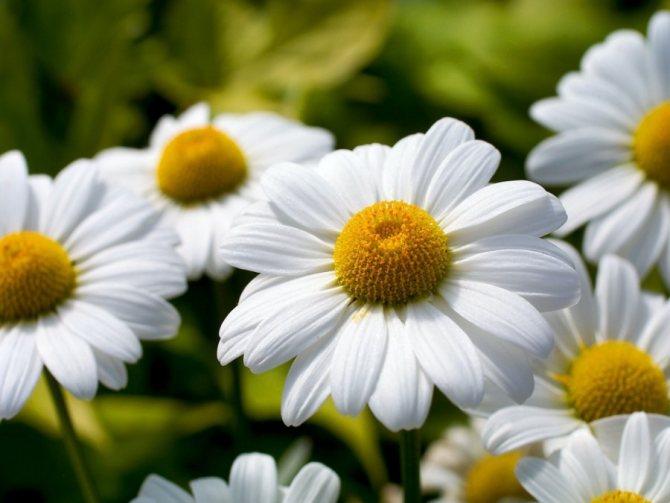

They are dug up, the roots are shaken off from the soil and the cuttings are selected, on each of which there should be at least one outlet. Delenki are transplanted at intervals of 30 cm.
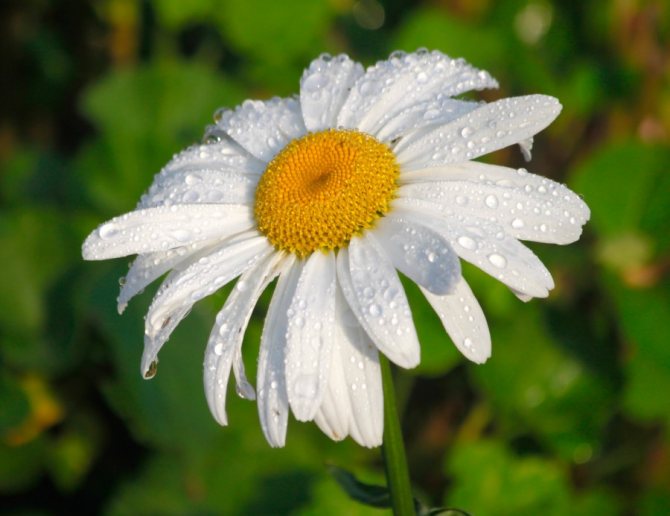

Harvesting a medicinal plant
Traditional medicine uses the ground parts of the plant for medicinal purposes: stems, leaves and flowers. Raw materials are harvested from June to the end of August.
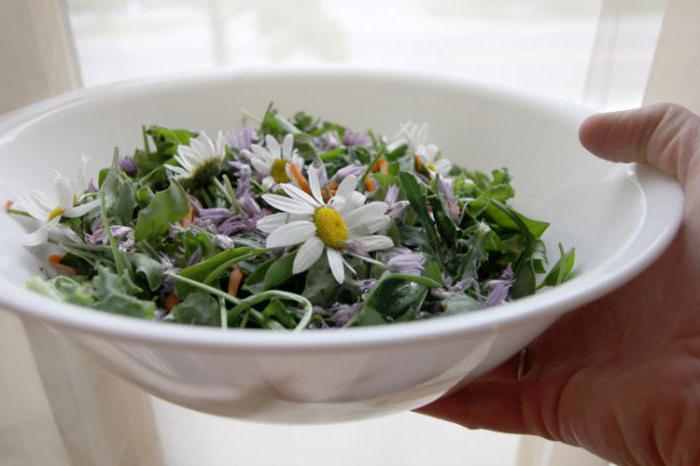

Garden shears cut the stem at a distance of 10-12 cm from the ground. The greens are first crushed and then dried in the open air under a canopy to protect the raw materials from direct sunlight. Store in glass containers or paper bags for up to two years.

